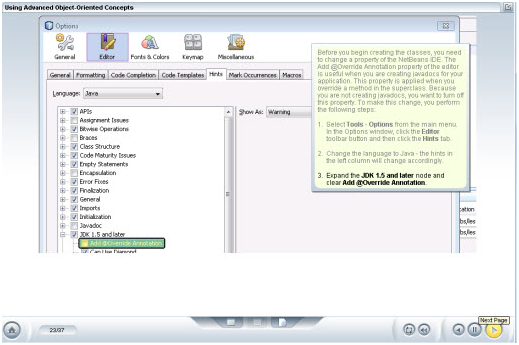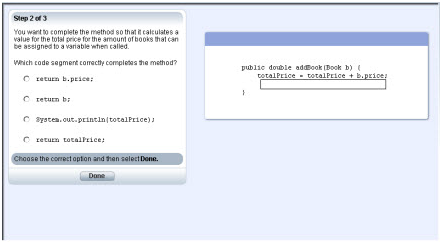 The Oracle Certified Associate for Java SE 7 Programmers requires only a single exam to become certified, and is required prior to achieving the designation of Oracle Certified Professional, Java SE 7 Programmer, which requires one additional exam. Oracle Certification differentiates candidates in the marketplace by providing a competitive edge through proven expertise. Up-to-date training and field experience are recommended. This course covers training for certification Exam 1Z0-803. The Oracle Certified Associate for Java SE 7 Programmers requires only a single exam to become certified, and is required prior to achieving the designation of Oracle Certified Professional, Java SE 7 Programmer, which requires one additional exam. Oracle Certification differentiates candidates in the marketplace by providing a competitive edge through proven expertise. Up-to-date training and field experience are recommended. This course covers training for certification Exam 1Z0-803.
The release of Java SE 7 brings a number of new features and enhancements. This course introduces and describes these features and improvements. The course also describes the operating systems and browser support, and Java SE 7 support in NetBeans IDE 7.0.1. It explores Java language enhancements, such as using Strings in switch statements, improved integral literals, improved type inference, improved exception handling, the try-with-resources statement, and simplified varargs method invocation. Core technology enhancements, such as the JVM enhancements - support for dynamically typed languages, the garbage-first collector, and upgraded class-loader architecture - as well as concurrency and collections, and JDBC enhancements, are also covered.
Java OCA Certification Training Course Includes
Full Multi-media interactive Online Tutorials
Hands-on Labs - a perfectly simulated, real-world environment to test skills without risk.
Practice Exams - Simulated certification exams designed to validate exam readiness.
Printable Transcripts of all lessons for easy review
Online Instructor Mentoring 24 7
Mentoring provides personal access to our talented corps of expert instructors in a unique collaborative environment. Students can correspond with the Instructor Team 24x7.
Training Tutorials Cover
New Features: Java Language and Technology Enhancements
- New Features: Java Language and Technology Enhancements
- New Features: I/O, Network, and Desktop Enhancements
- Introduction
- Variables, Operators, and Objects
- Decision Constructs, Arrays, and Loops
- Overloading, Validation, and Object-Oriented Concepts
- Handling Errors and Deploying Applications
New Features: I/O, Network, and Desktop Enhancements
- Enhancements in File I/O APIs
- Work with the Path interface
- Use the Files class to work with files or directories
- Files class to work with directories, links, and the File Tree
- Asynchronous I/O API and completion handlers
- Desktop enhancements in Java
- Asynchronous file channel API
- JLayer and LayerUI classes
- Formatted text fields
Introduction to Java
- Key concepts of the Java programming language
- Groups
- How IDEs help speed development time
- Sequence the stages in the product life cycle
- The features of objects, attributes, and operations
- Factors to consider when designing and modeling a class
- Define a class using Java
- How to test and execute a simple Java program
- Features of the IDE debugger
- Create a project in the NetBeans IDE
- How to use NetBeans to create and compile a Java class and to create a test program
- The features of the NetBeans debugger
Variables, Operators, and Objects
- Uses and the syntax of variables
- Declare variables
- How to modify variables using operators
- How to use promotion and type casting
- Variables in a field definition
- Operators and prevent data loss using type casting
- How to declare, instantiate, and initialize objects
- String and StringBuilder classes
- Classes and methods in the API documentation
Decision Constructs, Arrays, and Loops
- Use if and if/else constructs
- Switch statement
- Create a one-dimensional array
- Two-dimensional arrays
- ArrayList
- Develop while and for loops
- While loops
- Array in a loop and code and test a do/while loop
- Cate and populate an array list
- Manipulate an ArrayList
- Loops to process an ArrayList
Overloading, Validation, and Object-Oriented Concepts
- Create and invoke methods
- Method overloading
- Encapsulation in Java
- Create constructors
- Create and call methods with arguments and return values
- Implement encapsulation
- Constructors to initialize objects
- Create and use superclasses and subclasses
- Polymorphism and override methods
- The nterfaces
Handling Errors and Deploying Applications
- Handle an exception
- Catch and throw exceptions
- Features of packages and JAR files
- Client-server architecture
- Create a try/catch block to handle exceptions
- Custom exception

|











 The Oracle Certified Associate for Java SE 7 Programmers requires only a single exam to become certified, and is required prior to achieving the designation of Oracle Certified Professional, Java SE 7 Programmer, which requires one additional exam. Oracle Certification differentiates candidates in the marketplace by providing a competitive edge through proven expertise. Up-to-date training and field experience are recommended. This course covers training for certification Exam 1Z0-803.
The Oracle Certified Associate for Java SE 7 Programmers requires only a single exam to become certified, and is required prior to achieving the designation of Oracle Certified Professional, Java SE 7 Programmer, which requires one additional exam. Oracle Certification differentiates candidates in the marketplace by providing a competitive edge through proven expertise. Up-to-date training and field experience are recommended. This course covers training for certification Exam 1Z0-803.
